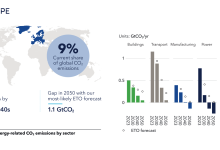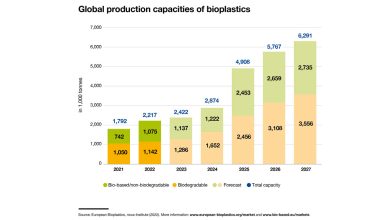EU natural gas demand revival: A window of opportunity for Romania
After six consecutive quarters of growth, the demand for natural gas in the European Union (EU) signals a firm upward trend. The continuation of the trend, which overlaps the process of re-launching the European economy, is also supported by forecasts indicating consumption increases for at least the next two decades. This is a good omen for Romania because it opens the window of opportunity our country has in view, the exploitation of the Black Sea natural gas blocks.
The EU natural gas demand has decreased by about 20% during the first half of the current decade, amid the fall in energy demand as a result of the crisis in particular; the decrease in gas consumption was ‘supported’, on the one hand, by the fall of the coal price and of the carbon emissions costs and, on the other hand, by the increase of energy output from renewable sources. One of the results of this phenomenon was the emergence of a gas surplus that stimulated the market flexibility and new investments in infrastructure (warehouses and/or transport infrastructure). These, in turn, had the effect of reducing the gaps between winter and summer prices, as well as a noticeable reduction of their volatility. Thus, in 2014, gas demand in the EU had a turning point; and between 2014 and 2016 it increased by about 52 billion cubic meters per year (bcmy) – with this trend continuing in 2017. The process of re-launching the European economy and turning energy producers from coal to natural gas were the main elements that have led to this change.
Six consecutive quarters of growth
The end of the second quarter of 2017 represented the sixth consecutive quarter of growth in demand (for consumption) of the Union’s gas market; preliminary Eurostat figures point to an increase of 11% y/y in Q2 2017 (against Q2 2016) (see the graph ‘Six consecutive quarters of growth’ in the print edition). Therefore, as reported by the Quarterly Report Energy on European Gas Markets (issue 2; second quarter of 2017) published in late September 2017, the 162 billion cubic meters of natural gas consumed in the EU in the first quarter (a new peak in consumption since the first quarter of 2013), were joined by about 100 billion cubic metres consumed in the second quarter, resulting in a consumption of about 260 billion cubic meters during the first six months of 2017.
The confirmation of the provisional figures for the second quarter would make the first half of 2017 register an increase in consumption by about 8% against the same period in 2016.
It should be noted, however, that this increase in consumption was mainly covered by external sources – Q2 2017 being the fourth consecutive quarter of imports’ growth; the increase in the volume of imported gas was higher in Q2 than in the previous quarters, thus offsetting the decrease by about 5% (y/y) of the domestic production (see the graph ‘EU gas consumption, imports and production’ in the print edition); on the other hand, it is noteworthy that during the first six months of the year, the domestic output marked a 2% increase against the same six months of 2016.
The upward trend in gas consumption in the EU countries is equally revealed by the annual dynamics, with figures showing an increase of 4% in 2015 as compared to 2014 and of 7% in 2016 as compared to 2015; the provisional statistics released by Eurostat are very likely to record a similar growth rate for 2017 (as compared to 2016) – which could lead the gas consumption close to the maximum level of 5,800 TWh recorded in 2010 (see the graph ‘2017 – the third year of gas consumption increase in the EU’ in the print edition).
Positive forecasts. Or not?
The positive prospects for the return of natural gas demand in the EU do not stop here! If we look in an optimistic key at the forecasts made by different specialized agencies, it may be concluded that the EU is only in the first part of a multiannual growth cycle in terms of gas consumption. The figures provided by the ‘European Gas Market: Myths and Realities’ study published by Gazprom in early July (2017), a study that centralizes the forecasts of several public and private entities, can be interpreted in this regard for the next two decades (see the graph ‘Forecasts on gas consumption in the EU’ in the print edition).
The study includes, as can be seen, the estimates of national or transnational public agencies (such as IEA, EIA, European Commission, ENTSOG), internationally recognized private entities (such as Wood Mackenzie and IHS CERA) or forecasts made by large private companies (such as Statoil, ExxonMobil or Gazprom Germany). The boldest ones show that gas demand in the EU could rise from about 542 bcmy by the end of 2016 to 656 bcmy in 2025 (as shown in the Enerdata forecast positive scenario) and/or up to 723 bcmy in 2035 (according to the EIA – the US Energy Information Administration forecast).
On the other hand, these estimates should be regarded with some caution! Because the average of the estimates contained in the study does not seem to give many reasons for optimism. Thus, this average is only 542 bcmy in 2025 and 540 bcmy in 2035 – it is therefore very close to the actual consumption level recorded in 2016. However, it should be considered that these averages also take into account the estimates made on the basis of negative scenarios. Among these is the negative prognosis of Enerdata, which for 2035 estimates a possible (minimum!) consumption of only 327 bcmy; another forecast on the downward – also based on a negative scenario – was released by Statoil, which, for 2035, estimates a (possible!) minimum consumption of 370 bcmy.
Besides the lows and highs in consumption forecasts mentioned above, however, the gap between domestic production and consumption needs over the next two decades is likely to grow. This is the conclusion reached by the calculations made by the Gazprom specialists, which shows that the consumption needs, which could not be covered by the EU domestic production (we are talking about the import needs), could be of 51 bcmy in 2025 and 84 bcmy in 2035 (see the graph ‘Supplementary gas demand on the rise’ in the print edition).
Opportunities and risks
We therefore have to deal with an obvious process of re-launching the gas demand at European level (with chances to remain) and, on the other hand, we have forecasts revealing that for the next two decades there would be a need for consumption that cannot be covered by the domestic output; in conclusion, on the EU market seems to be enough room for the absorption of new gas quantities. All these can become ‘anchors’ that would keep ajar, for Romania, the window of opportunity in view of exploiting the Black Sea deposits.
Thus, due to the return of natural gas demand, an uncertain project (given the context of low oil prices), such as the exploitation of the Black Sea natural gas reserves, becomes viable. A process the more necessary as the outcome of the royalties and operating conditions negotiating process could ultimately prove to be an inhibitor for the development of the respective projects by the involved companies; especially as discussions are ongoing in a rather turbulent political context (both nationally and regionally/European), which can always determine a ‘stand-by’ decision from the involved companies.
In such a context, the return of gas demand in the EU can therefore be an additional incentive for the companies involved in continuing the projects, despite the existing risks – both locally and regionally – such as the discussion launched by Hungary regarding the BRHA project (for which Hungarian officials wanted to have the ‘end of the line’ in Hungary, which would limit the direct access of Romanian gas to the Western European market).
Agri – a viable project?
There are even more constituent elements of this window of opportunity. Thus, besides the fact that it ‘anchors’ the viability of the Black Sea operations and it stimulates the completing of consistent investments in infrastructure on the territory of Romania (deposits, pipelines, interconnections, etc.), the return of gas demand in the EU and the prospects of maintaining the trend reopen talks on the opportunity of the AGRI project. This is because the European LNG imports in the second quarter of 2017 had a share of about 16% of total imports – the highest level in the last four years; in the second quarter of the year the LNG imports also increased by 10% (year-on-year) (see the graph ‘LNG imports at the highs of the last four years’ in the print edition) whereas the gas from the United States reached for the first time the terminals in the Netherlands, Poland and the United Kingdom (liquefied gas from the US was delivered hitherto exclusively to Southern Europe).
It should also be noted that, given the rise in spot prices in Asia, Europe was less attractive for LNG cargos during most of the 2016 – 2017 winter. This happened mainly because the hubs for liquefied gas, well-interconnected in Northern Europe, have had a strong competition from the gas transported by pipelines from Russia and Norway – which has also led to the drop in the volumes delivered to terminals in this part of Europe, increasing in turn the volumes delivered to the terminals of the Mediterranean countries. Only since May, due to prices, the liquefied gas has regained competitiveness, attracting a return in volumes, according to the statistics posted by LNG Edge.
The European Commission report and LNG Edge statistics therefore illustrate a trend to increase the share of LNG in total European gas imports and a trend to rebalance the share of hubs in northern Europe in favour of the South, concomitantly with the return in demand. The acknowledgement of these long-term trends puts a new light, including on the project of the LNG terminal in Constanta – the Romanian end of the line for AGRI project. Thus, the capital increase of S.C. AGRI LNG PROJECT COMPANY SRL, the company to develop the AGRI project (having as shareholders ROMGAZ – Romania, SOCAR – Azerbaijan and GOGC – Georgia), proposed for approval on November 16, could be anticipating this new possible reality. A changing reality both at European and international level, if we consider the dynamics of the Trans-oceanic movements!
Thus, the LNG deliveries worldwide grew by about 10% in volume in the third quarter of 2017 as compared to the same period of the previous year, reaching about 72.4 million tonnes – according to the most recent statistics available on the LNG Edge platform. They point to the significant increase in shipments from Australia (by 22% to 14.4 million tonnes) and to the fact that the US liquefied gas continued to be delivered to the Old Continent in the third quarter of 2017 too (to new destinations in the UK and Lithuania). In the second quarter of the year, the United States delivered no less than 470 million cubic meters of liquefied natural gas – to four different terminals (the Netherlands, Poland, Portugal and the UK) – accounting for 10% of the total LNG exports from the US over that time period, the LNG Edge statistics reveal; a new terminal, the fifth, was added in the third quarter of 2017 in Lithuania. Within this context, by the end of this year, amid increased capacity to export through two American terminals (Cove Point and Sabine Pass – under ongoing expansion), the deliveries to Europe are expected to grow.
Romania’s positioning
All these developments can be seen as significant elements of a possible strategy for Romania’s positioning as relevant player on the gas market in the Central and South-Eastern European area. A region with major deficiencies in terms of interconnection, compatibility and interoperability of the natural gas supply systems, where Romania has particular relevance – it is the largest market and the most important natural gas reserves holder, a know-how holder in the field and is in a relatively privileged geostrategic position, having as well an advance against the rest of the countries in the region in terms of enforcing the Single Market rules.
In addition, in order to speed up the integration of the regional gas markets and to diversify the natural gas supplies, Romania is involved along with Austria, Bulgaria, Croatia, Greece, Italy, Slovakia, Slovenia and Hungary, since February 2015, in setting up a working group under the name of CESEC (Central and South-Eastern Europe Gas Connectivity Group). Six partner countries, namely Albania, Bosnia-Herzegovina, Macedonia (FYROM), Moldova, Serbia and Ukraine have joined the group, with the aim of coordinating the efforts to achieve cross-border and trans-European projects that diversify sources and the gas supply routes and to harmonize the implementation of regulations meant to facilitate these projects.
So far, four ministerial meetings have taken place in Sofia, Zagreb, Budapest, the fourth taking place in Bucharest at the end of September 2017. The history of setting up the CESEC is related to the failure of the Nabucco project and the need for political and diplomatic support, at regional and European level, for strategic projects. The approach was therefore seen as a diplomatic co-ordination initiative in a region with a weak culture of cooperation and solidarity, in a region where the Member States’ energy policies show that each of them aspires to become a regional energy hub. The gradual expansion of CESEC’s geographic area increases the (geo)political complexity of its agenda and emphasizes the divergence in priorities and interests, but also offers the opportunity to develop large-scale regional projects based on complementary interests.
Even if ignoring the mentioned differences in interests, the challenges continue to be consistent – as revealed by the report ‘The State of Gas Market Integration in the Energy Community. Special Report for CESEC’ completed by the Commission after the high-level meeting in Bucharest on September 28. An important part of these challenges is related to the degree of adoption by the countries in the region of the European regulatory framework required for the efficient functioning of a gas market at regional level (see the graph ‘Aligning the CESEC States to the EU standards’ in the print edition).
Romania’s positioning in this context (of the difficulties in establishing the necessary framework for the functioning of a regional market) was highlighted by the end of 2016, through the report of a workshop on the ‘Security and Energy Diplomacy’ on the sidelines of THE ENERGY STRATEGY OF ROMANIA 2016-2030, IN VIEW OF 2050, under the aegis of the Academy of Economic Studies of Bucharest (ASE) (April 14, 2016). It is a report that highlights the fact that, although at regional level the construction of energy infrastructure is essential, the rules of operation and interoperability are even more important. Unfortunately, Romania (as well as Bulgaria) is far behind, although it should have reached this stage in 2009.
For example, the report reads, for natural gas, that in 20 of the 28 Member States there are virtual trading points (VTPs) in which the volumes of natural gas are traded after entry and before leaving a certain area of market. In Romania, they are not! Under these circumstances, we do not seem to have much chance of becoming a hub for the gas market in the region, given that many of our neighbours have already established their market model with virtual trading and operating principles (Croatia, for example, which joined the EU in 2013 and in 2014 already had a VTP). At the same time, Romania is still very poorly interconnected to its neighbours’ natural gas transmission networks as compared to the Central and Eastern European states (not to mention the Western European countries); the projects in this regard, although not missing, seem farther away to be put into operation by the day. This situation underlines the fact that Romania is not at the required level in terms of working and project management capacities (both at local and European level). Thus, the European Commission launched in November 2014 the European Strategic Investment Plan (EFSI), also known as the ‘Juncker Plan’, which aims to mobilize investments of at least EUR 315 billion by the end of 2017, targeting infrastructure and innovation projects, as well as support for small and medium-sized enterprises and medium-sized enterprises.
According to the balance sheet submitted by the Commission in April 2016, of the 200 projects proposed by Romania in December 2014, none was accepted for funding. Overall the 28 Member States have submitted 2,000 projects and projects from 25 Member States have been approved. Another negative example is the fact that Transgaz missed the race to takeover of the majority stake in the Greek gas carrier DESFA in the autumn of 2017.
It is true, however, that in 2015, SNTGN Transgaz SA benefited from a European funding of approximately EUR 180 million through the Connecting Europe financial facility, for the development of the Romanian section of the BRHA gas pipeline (Bulgaria-Romania-Hungary-Austria) as Project of Common Interest (PCI) at European level. It is a significant funding and an important step in supporting the development of the SNTGN (National Gas Transmission System) and of the reverse-flow interconnections with Bulgaria and Hungary; but Romania and the SEE region require far more investments to reach the standards comparable to industrialized countries.
Romanian-american partnership
On the other hand, due to the presence of US gas on the international market, to the dynamics of LNG flows and mainly to the dynamics and relevance of the US industry at global level, the US may be a partner to help Romania become a core component of the gas market in the region. The cooperation between the United States and Romania in the field of natural gas could be improved to the level of the political and military one, according to a recent study by the US think-tank CEPA quoted in the ESA report on the sidelines of the ENERGY STRATEGY OF ROMANIA 2016-2030, IN VIEW OF 2050.
Organizing a specialized mission (under the aegis of the US Department of Commerce, with leading energy companies to explore investment opportunities in Romania) was the first of the necessary conditions so that a possible partnership stands chances, according to the analysis conducted by the Romanian specialists in the aforementioned report. A condition that was met relatively soon: at the end of October 2017, Bucharest hosted the ‘Trade Winds 2017’ – a US trade mission meant to create business partnerships between the US and Southeast European countries (aiming Romania, Bulgaria, Croatia, Greece and Serbia). During October 16 – 24, the 10th edition mission was the largest American commercial presence in the history of this region. This can open up talks on Romania’s chances of becoming an operational base with US assistance to implement terms that are in line with the Energy Union objectives; this was a second condition for repositioning Romania in the region, of the three conditions included in the report drawn under the aegis of ASE.
Romania’s main problem is related to the diplomatic capacity to support its energy interests. We are talking about the need for ‘diplomacy’ in the traditional sense… but to be effective, it needs to be doubled by actions by all stakeholders in the field – such as non-governmental organizations, energy companies, the academic community and/or even other ministries (Ministry of Economy, Research, Education, etc.). It is a problem to be solved on which depends Romania’s chance to take advantage of the window of opportunity opened by the re-launching of gas consumption in the European Union. Yet, a matter harder to overcome than it may seem.







